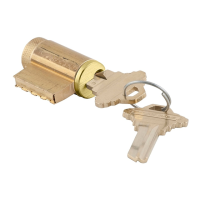Cutting Everest 29 keys on the blue punch
Schlage • Everest full size cylinder service manual • 15
Cutting Everest 29 keys on the blue punch
Handle
L-Handle
Die Carriage
Bottom Jaw
Cover Plate
Depth Number
Key Gauge
Depth Bar
Red Knob
Top Jaw
Bottom Jaw
Key Stop
Clamp Into Groove
Between Ribs
The original version of this popular key machine was
developed in the mid-1970’s. Pro-Lok
®
is the most recent in
the succession of companies that have manufactured the
machine. Even if you have what appears to be an original
Schlage punch (40-126), it was made by one of the earlier
companies. The basic principles are the same for all versions
of the machine, but there are minor differences in the vise
jaws which affect the machine’s ability to cut Everest C &
Everest 29 S Family keys.
Machines made before July 1999 were not designed to hold
Everest keys. Most of these machines have a thin top vise jaw
made of stamped steel. Some machines will hold Everest
keys, except sections with “45” in the designation (such as
C145). Even the first generation solid steel jaw was produced
before Everest keys existed and must be replaced.
You may be able to alter your old
style jaw by slightly elongating the
hole, so it can travel far enough to
engage in C145’s & S145 groove.
However, this solution should only
be a temporary measure until you
install the 40-074 upgrade
package with the properly shaped
top jaw.
In the close-up illustrations of the vise, notice the different
positions of the top jaw required to engage the grooves and
seat the different shapes of Schlage key sections properly.
Obverse Key Sections
C, CE, E, EF, F, FG, G, H, J, K, L
Most Everest and Everest 29
Key Sections:
C100, C120, C123, C124,
C135, C150
S100, S120, S123, S124,
S135, S150
Everest and Everest 29 "45" Sections:
C145, C245, C345
S145, S245, S345
Not only must the top
jaw engage in
different places
up and down
the side of the
various key
sections, but
the lever or knob
screw must be
tightened or loosened
substantially. Loosening and tightening the lever or knob
screw allows enough travel in the top jaw to accommodate
the difference in thickness between Classic and Everest 29
key sections, and to adjust for the angles at which the top jaw
sits.
Elongate
Le end
of vise
Loosen knob
and li jaw.
Loosen knob
and li jaw
toward top
of key blade.

